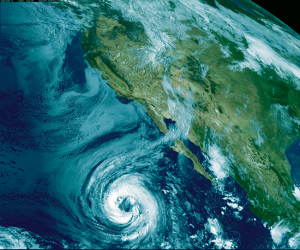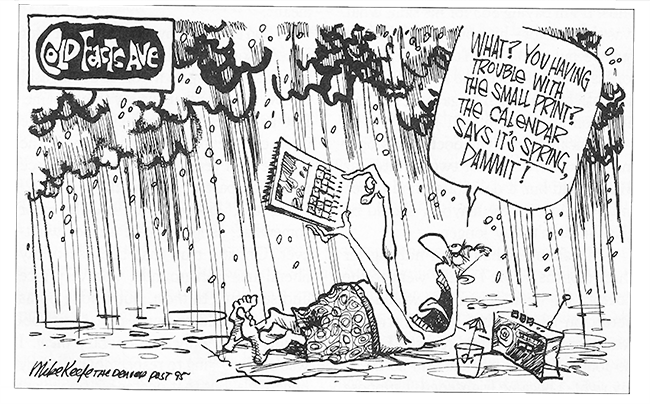Concerning Our Failure to Appreciate the Weather
 © Stocktrek Images
© Stocktrek Images Twenty years ago I came across a cartoon by Mike Keefe that captured an attitude I had found all too pervasive among my fellow Americans: the attitude of entitlement and detached disregard for understanding how our global climate system operates.
It inspired me to write an essay describing my understanding of our planet’s climate system, and it was published in the November/December 1995 issue of the Humanist. Rereading it, I notice some minor errors but the basic story remains as accurate today as it was back then. Since anniversaries are a good time to reflect on history and how far we’ve come (or not), I think it’s worth recalling where our understanding of climate change was twenty years ago.
Though there were fewer media outlets back then, they were more objective and for the most part offered straightforward climate science information. After all, it’s not that tough a story to summarize, even if the details get devilishly difficult.
By ’95 we had learned that weather is the product of climate conditions and that Earth’s climate conditions fluctuated. We knew that CO2 and other greenhouse gases were a major regulator of those fluctuations.
At the same time we were also being forced to confront the reality that it was our own burning of fossil fuels and the machines behind our modern marvels and lavish lifestyles that were increasingly belching “gaseous insulation” into our atmosphere.
Back then we were thinking about the Keeling Curve, the mother of all CO2 concentration graphs. Consider for a moment that before the industrial revolution our global climate system had its CO2 regulator slowly fluctuating between about 180 ppm (parts per million) to 280 ppm. And I mean slowly, taking tens of thousands of years to go from peak to trough (±100 ppm), with profound changes from ice ages to temperate periods.
Around 1850 this gaseous regulator was set at the prehistoric peak of ±280 ppm, but by 1995 this greenhouse gas regulator increased 80 clicks, up to 360 ppm. It has taken only twenty years to ratchet up another forty clicks and bust through 400 ppm, which is setting up the earth for a hothouse future.
This added atmospheric insulation warms our climate system. Simple undeniable physics! This warming then forces the troposphere to hold more moisture.
I believe cartoonist Keefe’s storm clouds were a reminder of the increasing tempo of “rogue” weather events we had been witnessing. For instance, in the United States we had the great 1980 drought and heat wave that killed thousands; the wild 1982-83 season, with its El Niño-driven storms and floods; an ugly drought in Australia; and some crazy cyclone behavior in the Pacific. 1988 brought another massive and costly drought and heat wave, 1991 saw the Oakland Hills firestorm, and in 1992 category-five Hurricane Andrew hit the Atlantic, category four Iniki struck Hawaii, and the Pacific Ocean had its most powerful cyclone season in recorded history. The year ended with the colossal Nor’easter of ’92. Since dubbed “The Perfect Storm,” it was a reminder for all who were paying attention that global weather systems interact with each other and their cumulative energy is capable of extraordinary outbursts. For the next three years an amazing four extreme weather calamities hit the United States annually.
I like to think Keefe was mocking the studied avoidance found in growing numbers of citizens. The science was becoming clearer as to our impact on climate, with headlines of these events including phrases such as “wake up call.” Indeed, we were waking up to the fact that it was our own collective behavior and expectations driving this global problem; the escalating consumption we’d fallen in love with was the cancer that would continue raising our planet’s temperature. However, this dawning realization created a profound cognitive dissonance.

Mike Keefe’s cartoon reprinted with permission of the cartoonist.
The stark historic reality was this: power down or radically alter our planet’s global climate system and the biosphere upon which we all depend. Yes, that meant consuming less and in smarter ways. It also meant burning less fossil fuels and making fewer babies.
Republican and libertarian players took advantage of the power of cognitive dissonance and created a network of right-wing think tanks and PR fronts. With hindsight it’s easy to see their long-term, two-pronged approach. First, there was the enlisting and cultivating of certain profit-focused evangelical interests to foster faith-based communities that were emotionally hostile towards evidence-based learning and rational constructive discourse. The other depended on orchestrating dirty tricks, creating scandals, and lying about the scientific evidence, along with misrepresentation of and personal attacks against scientists themselves.
Instead of promoting curiosity or interest in learning about what was happening to our planet, they created an alternate universe of faux science that conformed to their ideology and to their political and business objectives. To hell with understanding observations and facts regarding Earth. The “merchants of doubt,” to borrow a phrase from Naomi Oreskes, became masters of deception and spin. For instance, after a record-smashing hot 1998, global surface temperatures plateaued and didn’t rise as fast as some expected.
By 2006 the spin masters started crying “no global warming!” with such insistence and wily finesse that they even got the scientific community all atwitter about an imaginary “global warming hiatus.”
It seemed like everyone forgot the unavoidable basics: It’s our planet’s atmospheric insulation doing the heavy lifting on this global warming thing.
The troposphere (Earth’s lowest layer of atmosphere) is huge and complex; heat is absorbed and moved around in myriad ways so it’s no surprise that scientists don’t have a perfect inventory of where every joule of heat is going. What matters is how atmospheric greenhouse gases are retaining heat, and that process scientists do understand—thoroughly. It doesn’t turn on and off; the “global warming hiatus” was an illusion from day one.
The question everyone should have been asking was: “Where did the surface heat go?” The answer turns out to be a combination of oceans and difficulties in deducing the “average” global surface temperature in the first place.
Another PR ringer is the soothing mantra that held some rational justification in the 1960s and ’70s, perhaps even in the ’80s, but has become increasingly disconnected from reality: “No single storm is proof of global warming.” The success of this bit of tactical misdirection has been astonishing and far-reaching. Even serious scientists glommed onto it. But it ignores the basic physical reality that weather is the tool of our climate and climate is dependent on the composition of the atmosphere.
Climate is a heat and moisture distribution engine. Weather is the physical tool that does the work of distributing the sun’s heat and hot moisture-laden air masses that our equatorial belt is constantly churning out. It follows that no weather event is independent of the overarching warming of our weather-making engine. So, what’s up with the wishful avoidance?
Flash forward to 2015 and the earth is experiencing its warmest year in recorded history. Extreme weather events continue breaking records, yet business leaders, their politicians, and their faithful continue to ignore everything climate scientists and observations have to teach them about our one and only planet.
We face a make-or-break challenge: Will we grow up and get serious about our impacts upon this one and only, finite home of ours? Will our politicians and business leaders muster the courage to take the threats to civilization seriously?
There are many who see this as the people’s project. Citizens’ Climate Lobby (CCL), for example, is a nonprofit, nonpartisan advocacy group that trains and supports volunteers to engage elected officials, the media, and the public on the need to act to mitigate climate change. They are gearing up for the upcoming UN Climate Change Conference in Paris and need more support. If you care about the health of our planet, here’s your chance to step up and be a global citizen; check out CCL’s “Pathway to Paris” website and lend your support.
